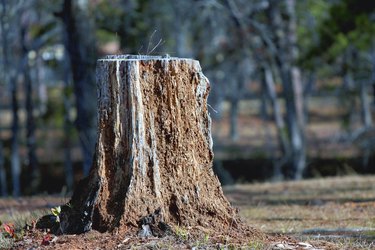
A tree can become a nuisance or safety hazard, whether due to its falling fruit, weak wood or disease, and you may have removed such a tree. Even though you chop down a tree, however, it may grow back. In fact, some cut trees sprout quickly, depending on their type, root health and general growing conditions.
Understanding the Roots
Video of the Day
A tree's roots stop growing when the tree is chopped down. Without leaves, the plant cannot produce food, and food is what fuels root growth. The roots, however, might have enough fuel from food left in them to produce sprouts from themselves or from the remains of the trunk, the stump. If a sprout develops enough leaves, then it can grow into a new tree. Sprouts also are called "suckers."
Video of the Day
Removing the Suckers
Unless you want new trees to grow from a tree stump or its roots, it's best to remove the sprouts as soon as they appear. Cut them off just below the soil surface or, even better, cut them off where they meet the roots or stump, removing a part of each affected root or the stump in the process. Suckers removed by hand may return the next year or even later in the current growing season, depending on the tree and how many nutrients remain in the roots.
Killing the Roots
A more permanent option then removing suckers is to paint herbicide onto the leaves of the suckers. The leaves will absorb the poison, and the roots will draw it into them; the process usually kill the roots within one year, according to a Colorado State University Denver County Extension Master Gardener article. Painting herbicide on the surface of a freshly cut stump also helps to kill the tree's roots and prevent them from sprouting. Use a ready-to-use herbicide, taking care to apply it on a dry, still day. Ensure the product contains either triclopyr-amine or glyphosate, although triclopyr-amine is more likely than glyphosate to kill a tree. Cover the sucker leaves or top of the stump thoroughly with the herbicide by using a paintbrush. Protect your skin with clothing and your eyes with goggles while handling and applying the herbicide, and discard the paintbrush in the trash immediately after using it.
Hiding the Stump
If you want the tree to grow again, then leave the stump alone and, if conditions are right, eventually new growth will cover the stump. If, however, you decide to control the suckers and do so successfully, then the stump presents a new problem -- a potentially unattractive one. A stump grinder can be used to get rid of a stump, but that service can be expensive. Instead, consider using your stump as a way to add vertical interest to your yard. Place pots containing brightly colored annual plants on top of the stump, or even put a birdbath or bird feeder on the stump if its top is level. A flowering vine may cover it nicely; just ensure the vine isn't a species that becomes invasive. Another option is to hide the stump behind a bench or even under a pretty patio table.